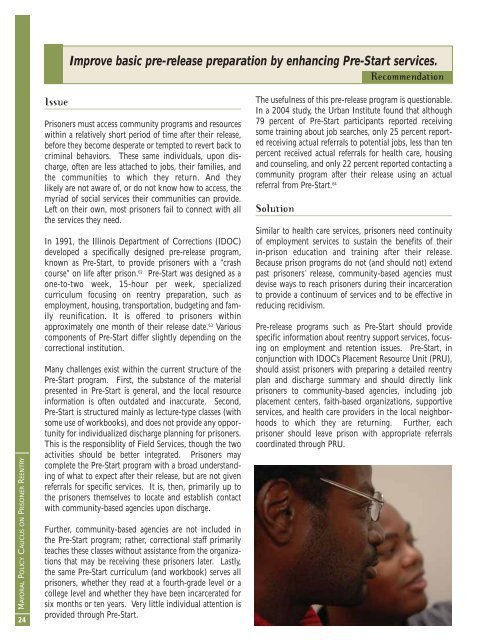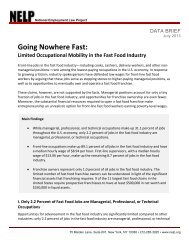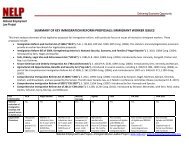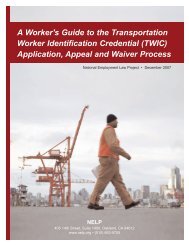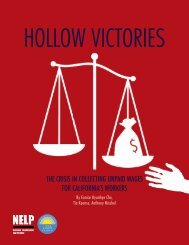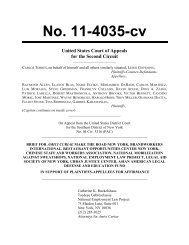Rebuilding Lives. Strengthening Communities.
Rebuilding Lives. Strengthening Communities.
Rebuilding Lives. Strengthening Communities.
You also want an ePaper? Increase the reach of your titles
YUMPU automatically turns print PDFs into web optimized ePapers that Google loves.
Improve basic pre-release preparation by enhancing Pre-Start services.<br />
Recommendation<br />
MAYORAL POLICY CAUCUS ON PRISONER REENTRY<br />
24<br />
Issue<br />
Prisoners must access community programs and resources<br />
within a relatively short period of time after their release,<br />
before they become desperate or tempted to revert back to<br />
criminal behaviors. These same individuals, upon discharge,<br />
often are less attached to jobs, their families, and<br />
the communities to which they return. And they<br />
likely are not aware of, or do not know how to access, the<br />
myriad of social services their communities can provide.<br />
Left on their own, most prisoners fail to connect with all<br />
the services they need.<br />
In 1991, the Illinois Department of Corrections (IDOC)<br />
developed a specifically designed pre-release program,<br />
known as Pre-Start, to provide prisoners with a “crash<br />
course” on life after prison. 62 Pre-Start was designed as a<br />
one-to-two week, 15-hour per week, specialized<br />
curriculum focusing on reentry preparation, such as<br />
employment, housing, transportation, budgeting and family<br />
reunification. It is offered to prisoners within<br />
approximately one month of their release date. 63 Various<br />
components of Pre-Start differ slightly depending on the<br />
correctional institution.<br />
Many challenges exist within the current structure of the<br />
Pre-Start program. First, the substance of the material<br />
presented in Pre-Start is general, and the local resource<br />
information is often outdated and inaccurate. Second,<br />
Pre-Start is structured mainly as lecture-type classes (with<br />
some use of workbooks), and does not provide any opportunity<br />
for individualized discharge planning for prisoners.<br />
This is the responsiblity of Field Services, though the two<br />
activities should be better integrated. Prisoners may<br />
complete the Pre-Start program with a broad understanding<br />
of what to expect after their release, but are not given<br />
referrals for specific services. It is, then, primarily up to<br />
the prisoners themselves to locate and establish contact<br />
with community-based agencies upon discharge.<br />
Further, community-based agencies are not included in<br />
the Pre-Start program; rather, correctional staff primarily<br />
teaches these classes without assistance from the organizations<br />
that may be receiving these prisoners later. Lastly,<br />
the same Pre-Start curriculum (and workbook) serves all<br />
prisoners, whether they read at a fourth-grade level or a<br />
college level and whether they have been incarcerated for<br />
six months or ten years. Very little individual attention is<br />
provided through Pre-Start.<br />
The usefulness of this pre-release program is questionable.<br />
In a 2004 study, the Urban Institute found that although<br />
79 percent of Pre-Start participants reported receiving<br />
some training about job searches, only 25 percent reported<br />
receiving actual referrals to potential jobs, less than ten<br />
percent received actual referrals for health care, housing<br />
and counseling, and only 22 percent reported contacting a<br />
community program after their release using an actual<br />
referral from Pre-Start. 64<br />
Solution<br />
Similar to health care services, prisoners need continuity<br />
of employment services to sustain the benefits of their<br />
in-prison education and training after their release.<br />
Because prison programs do not (and should not) extend<br />
past prisoners’ release, community-based agencies must<br />
devise ways to reach prisoners during their incarceration<br />
to provide a continuum of services and to be effective in<br />
reducing recidivism.<br />
Pre-release programs such as Pre-Start should provide<br />
specific information about reentry support services, focusing<br />
on employment and retention issues. Pre-Start, in<br />
conjunction with IDOC’s Placement Resource Unit (PRU),<br />
should assist prisoners with preparing a detailed reentry<br />
plan and discharge summary and should directly link<br />
prisoners to community-based agencies, including job<br />
placement centers, faith-based organizations, supportive<br />
services, and health care providers in the local neighborhoods<br />
to which they are returning. Further, each<br />
prisoner should leave prison with appropriate referrals<br />
coordinated through PRU.


